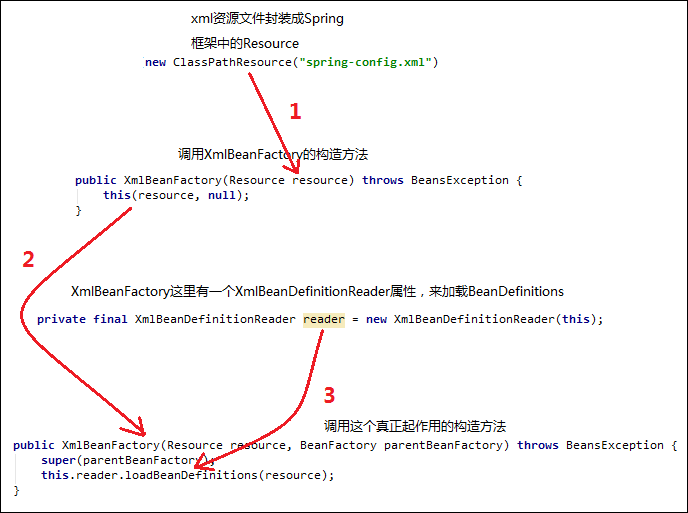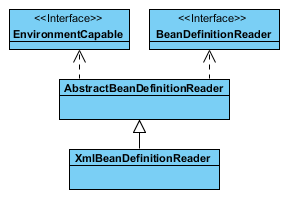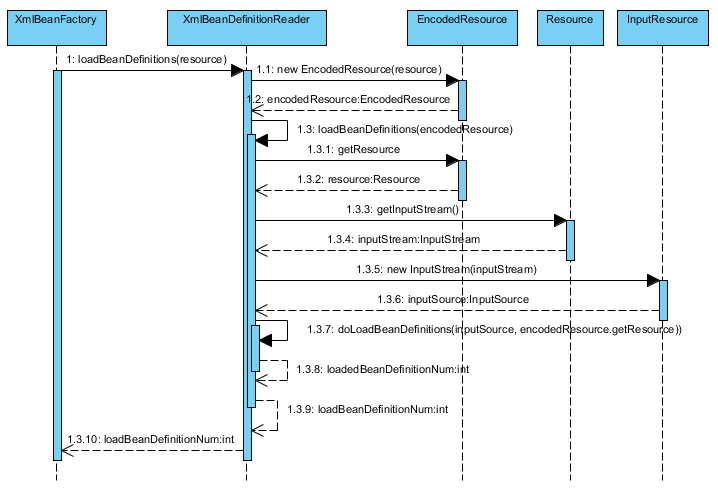Spring源码学习(一)资源加载
这里先从最简单的一个Spring例子开始。
下面是Spring的context的配置
1 <?xml version="1.0" encoding="UTF-8"?>
2 <beans xmlns="http://www.springframework.org/schema/beans"
3 xmlns:context="http://www.springframework.org/schema/context"
4 xmlns:xsi="http://www.w3.org/2001/XMLSchema-instance"
5 xsi:schemaLocation="http://www.springframework.org/schema/context
6 http://www.springframework.org/schema/context/spring-context.xsd
7 http://www.springframework.org/schema/beans
8 http://www.springframework.org/schema/beans/spring-beans.xsd">
9
10 <!-- 自动扫描web包 ,将带有注解的类 纳入spring容器管理 -->
11 <context:component-scan base-package="com.tuhooo.practice"></context:component-scan>
12 </beans>
一个简单的Service类,MyBean.java
1 @Service
2 public class MyBean {
3 public void printStr() {
4 System.out.println("你好吗......");
5 }
6 }
main方法中获取bean,并调用MyBean.java中的方法。
1 public class App {
2 public static void main( String[] args ) {
3 XmlBeanFactory applicationContext = new XmlBeanFactory(new ClassPathResource("spring-config.xml"));
4 MyBean myBean = (MyBean) applicationContext.getBean("myBean");
5 myBean.printStr();
6 }
7 }
当我在使用XmlBeanFactory这个类的时候,已经被标记为@deprecated,也就是这个类已经被抛弃了,但是并不妨碍它作为我们滴入口类进行分析呀。
XmlBeanFactory.java
1 @Deprecated
2 @SuppressWarnings({"serial", "all"})
3 public class XmlBeanFactory extends DefaultListableBeanFactory {
4
5 /**
6 * 加载Bean定义的Reader
7 */
8 private final XmlBeanDefinitionReader reader = new XmlBeanDefinitionReader(this);
9
10 /**
11 * 通过给定的可通过DOM解析的资源来创建一个XmlBeanFactory
12 * @param resource 用来加载bean定义的XML资源
13 * @throws BeansException 加载或者解析时候的错误
14 */
15 public XmlBeanFactory(Resource resource) throws BeansException {
16 this(resource, null);
17 }
18
19 /**
20 * 通过给定的可通过DOM解析的输入流来创建一个XmlBeanFactory
21 * @param resource 用来加载bean定义的XML资源
22 * @param parentBeanFactory 父代的bean factory
23 * @throws BeansException 加载或者解析时候的错误
24 */
25 public XmlBeanFactory(Resource resource, BeanFactory parentBeanFactory) throws BeansException {
26 super(parentBeanFactory);
27 this.reader.loadBeanDefinitions(resource); /*这个是我们要进入, 并分析的方法*/
28 }
29 }

接下来看一下XmlBeanDefinitionReader中的loadBeanDefinitions(resource)的逻辑是怎样的。
XmlBeanDefinitionReader.loadBeanDefinitions(resource)
XmlBeanDefinitionReader的类图如下:

下面是XmlBeanDefinitionReader.java这个类截取的一部分:
public class XmlBeanDefinitionReader extends AbstractBeanDefinitionReader {
/**
* Load bean definitions from the specified XML file.
* @param resource the resource descriptor for the XML file
* @return the number of bean definitions found
* @throws BeanDefinitionStoreException in case of loading or parsing errors
*/
@Override
public int loadBeanDefinitions(Resource resource) throws BeanDefinitionStoreException {
return loadBeanDefinitions(new EncodedResource(resource));
}
/**
* Load bean definitions from the specified XML file.
* @param encodedResource the resource descriptor for the XML file,
* allowing to specify an encoding to use for parsing the file
* @return the number of bean definitions found
* @throws BeanDefinitionStoreException in case of loading or parsing errors
*/
public int loadBeanDefinitions(EncodedResource encodedResource) throws BeanDefinitionStoreException {
Assert.notNull(encodedResource, "EncodedResource must not be null");
if (logger.isInfoEnabled()) {
logger.info("Loading XML bean definitions from " + encodedResource.getResource());
}
Set<EncodedResource> currentResources = this.resourcesCurrentlyBeingLoaded.get();
if (currentResources == null) {
currentResources = new HashSet<>(4);
this.resourcesCurrentlyBeingLoaded.set(currentResources);
}
if (!currentResources.add(encodedResource)) {
throw new BeanDefinitionStoreException(
"Detected cyclic loading of " + encodedResource + " - check your import definitions!");
}
try {
InputStream inputStream = encodedResource.getResource().getInputStream();
try {
InputSource inputSource = new InputSource(inputStream);
if (encodedResource.getEncoding() != null) {
inputSource.setEncoding(encodedResource.getEncoding());
}
return doLoadBeanDefinitions(inputSource, encodedResource.getResource());
}
finally {
inputStream.close();
}
} catch (IOException ex) {
throw new BeanDefinitionStoreException(
"IOException parsing XML document from " + encodedResource.getResource(), ex);
} finally {
currentResources.remove(encodedResource);
if (currentResources.isEmpty()) {
this.resourcesCurrentlyBeingLoaded.remove();
}
}
}
}
可以对着这个时序图,看来下面的代码:


下面我们进入到XmlBeanDefinitionReader.loadBeanDefinitions(EncodedResource encodedResource)方法内部看一下。

这里EncodedResource验重的逻辑是:
public class EncodedResource implements InputStreamSource {
@Override
public boolean equals(Object other) {
if (this == other) {
return true;
}
if (!(other instanceof EncodedResource)) {
return false;
}
EncodedResource otherResource = (EncodedResource) other;
return (this.resource.equals(otherResource.resource) &&
ObjectUtils.nullSafeEquals(this.charset, otherResource.charset) &&
ObjectUtils.nullSafeEquals(this.encoding, otherResource.encoding));
}
}
这个loadBeanDefinitions方法还是很清晰的,你说像我这种制杖都看懂了,就想说一句,还有谁看不懂~~~
但仍有几个地方需要后续再跟进看一下:
1. 这里有个局部线程变量来存放正在加载的资源,this.resourceCurrentlyBeingLoaded.get(),可以我们看到线程在哪儿?
2. 你说搞encodedResource我理解,但是为什么在doLoadBeanDefinitions方法中既有inputSource,又有encodedResource,不会显得很多余么?
XmlBeanDefinitionReader.doLoadBeanDefinitions(InputSource, Resource)
1 public class XmlBeanDefinitionReader extends AbstractBeanDefinitionReader {
2
3 /**
4 * Actually load bean definitions from the specified XML file.
5 * @param inputSource the SAX InputSource to read from
6 * @param resource the resource descriptor for the XML file
7 * @return the number of bean definitions found
8 * @throws BeanDefinitionStoreException in case of loading or parsing errors
9 * @see #doLoadDocument
10 * @see #registerBeanDefinitions
11 */
12 protected int doLoadBeanDefinitions(InputSource inputSource, Resource resource)
13 throws BeanDefinitionStoreException {
14 try {
15 Document doc = doLoadDocument(inputSource, resource);
16 return registerBeanDefinitions(doc, resource);
17 }
18 catch (BeanDefinitionStoreException ex) {
19 throw ex;
20 }
21 catch (SAXParseException ex) {
22 throw new XmlBeanDefinitionStoreException(resource.getDescription(),
23 "Line " + ex.getLineNumber() + " in XML document from " + resource + " is invalid", ex);
24 }
25 catch (SAXException ex) {
26 throw new XmlBeanDefinitionStoreException(resource.getDescription(),
27 "XML document from " + resource + " is invalid", ex);
28 }
29 catch (ParserConfigurationException ex) {
30 throw new BeanDefinitionStoreException(resource.getDescription(),
31 "Parser configuration exception parsing XML from " + resource, ex);
32 }
33 catch (IOException ex) {
34 throw new BeanDefinitionStoreException(resource.getDescription(),
35 "IOException parsing XML document from " + resource, ex);
36 }
37 catch (Throwable ex) {
38 throw new BeanDefinitionStoreException(resource.getDescription(),
39 "Unexpected exception parsing XML document from " + resource, ex);
40 }
41 }
42 }
最终把硬盘上的配置文件以Document的形式读到了内存中。

XmlBeanDefinitionReader.registerBeanDefinitions(Document, Resource)
1 public class XmlBeanDefinitionReader extends AbstractBeanDefinitionReader {
2
3 public int registerBeanDefinitions(Document doc, Resource resource) throws BeanDefinitionStoreException {
4 BeanDefinitionDocumentReader documentReader = createBeanDefinitionDocumentReader();
5 int countBefore = getRegistry().getBeanDefinitionCount();
6 documentReader.registerBeanDefinitions(doc, createReaderContext(resource));
7 return getRegistry().getBeanDefinitionCount() - countBefore;
8 }
9
10 /**
11 * Create the {@link BeanDefinitionDocumentReader} to use for actually
12 * reading bean definitions from an XML document.
13 * <p>The default implementation instantiates the specified "documentReaderClass".
14 * @see #setDocumentReaderClass
15 */
16 protected BeanDefinitionDocumentReader createBeanDefinitionDocumentReader() {
17 return BeanDefinitionDocumentReader.class.cast(BeanUtils.instantiateClass(this.documentReaderClass));
18 }
19
20 /**
21 * Create the {@link XmlReaderContext} to pass over to the document reader.
22 */
23 public XmlReaderContext createReaderContext(Resource resource) {
24 return new XmlReaderContext(resource, this.problemReporter, this.eventListener,
25 this.sourceExtractor, this, getNamespaceHandlerResolver());
26 }
27 }
28
首先不看别的,直接看这段代码就行:
1. 构造一个BeanDefinitionDocumentReader,然后用它来注册BeanDefinition,它还需要一个读取时候的上下文;
2. 返回的是新加入Registry的BeanDefinition的个数
3. createBeanDefinitionDocumentReader的作用还没看太明白

DefaultBeanDefinitionDocumentReader.registerBeanDefinitions

再去看一下doRegisterBeanDefinitions方法

真正处理的方法又流转到了parseBeanDefinitions中,但是我没明白delegate是干啥啊?
Resource的类图

public class ClassPathResource extends AbstractFileResolvingResource {
/**
* Create a new {@code ClassPathResource} for {@code ClassLoader} usage.
* A leading slash will be removed, as the ClassLoader resource access
* methods will not accept it.
* <p>The thread context class loader will be used for
* loading the resource.
* @param path the absolute path within the class path
* @see java.lang.ClassLoader#getResourceAsStream(String)
* @see org.springframework.util.ClassUtils#getDefaultClassLoader()
*/
public ClassPathResource(String path) {
this(path, (ClassLoader) null);
}
/**
* Create a new {@code ClassPathResource} for {@code ClassLoader} usage.
* A leading slash will be removed, as the ClassLoader resource access
* methods will not accept it.
* @param path the absolute path within the classpath
* @param classLoader the class loader to load the resource with,
* or {@code null} for the thread context class loader
* @see ClassLoader#getResourceAsStream(String)
*/
public ClassPathResource(String path, @Nullable ClassLoader classLoader) {
Assert.notNull(path, "Path must not be null");
String pathToUse = StringUtils.cleanPath(path);
if (pathToUse.startsWith("/")) {
pathToUse = pathToUse.substring(1);
}
this.path = pathToUse;
this.classLoader = (classLoader != null ? classLoader : ClassUtils.getDefaultClassLoader());
}
}
在代码new ClassPathResource("beanFactoryTest.xml");中其实没有啥动作,就是对ClassPathResource的几个属性赋值了,尤其是类加载器。也就是说这个时候其实并没有读取文件内容。
Spring源码学习(一)资源加载的更多相关文章
- Mybatis源码学习之资源加载(六)
类加载器简介 Java虚拟机中的类加载器(ClassLoader)负责加载来自文件系统.网络或其他来源的类文件.Java虚拟机中的类加载器默认使用的是双亲委派模式,如图所示,其中有三种默认使用的类加载 ...
- 【Spring源码分析】Bean加载流程概览
代码入口 之前写文章都会啰啰嗦嗦一大堆再开始,进入[Spring源码分析]这个板块就直接切入正题了. 很多朋友可能想看Spring源码,但是不知道应当如何入手去看,这个可以理解:Java开发者通常从事 ...
- 【Spring源码分析】Bean加载流程概览(转)
转载自:https://www.cnblogs.com/xrq730/p/6285358.html 代码入口 之前写文章都会啰啰嗦嗦一大堆再开始,进入[Spring源码分析]这个板块就直接切入正题了. ...
- Spring源码分析:Bean加载流程概览及配置文件读取
很多朋友可能想看Spring源码,但是不知道应当如何入手去看,这个可以理解:Java开发者通常从事的都是Java Web的工作,对于程序员来说,一个Web项目用到Spring,只是配置一下配置文件而已 ...
- 【Spring源码分析系列】加载Bean
/** * Create a new XmlBeanFactory with the given input stream, * which must be parsable using DOM. * ...
- flutter源码学习笔记-图片加载流程
本文基于1.12.13+hotfix.8版本源码分析. 0.大纲 Image ImageProvider 图片数据加载 ImageStream.ImageStreamCompleter 缓存池 Pai ...
- Spring源码解析-配置文件的加载
spring是一个很有名的java开源框架,作为一名javaer还是有必要了解spring的设计原理和机制,beans.core.context作为spring的三个核心组件.而三个组件中最重要的就是 ...
- 五、spring源码阅读之ClassPathXmlApplicationContext加载beanFactory
ApplicationContext applicationContext = new ClassPathXmlApplicationContext("spring-config.xml&q ...
- Spring源码学习-容器BeanFactory(一) BeanDefinition的创建-解析资源文件
写在前面 从大四实习至今已一年有余,作为一个程序员,一直没有用心去记录自己工作中遇到的问题,甚是惭愧,打算从今日起开始养成写博客的习惯.作为一名java开发人员,Spring是永远绕不过的话题,它的设 ...
- Spring源码学习-容器BeanFactory(三) BeanDefinition的创建-解析Spring的默认标签
写在前面 上文Spring源码学习-容器BeanFactory(二) BeanDefinition的创建-解析前BeanDefinition的前置操作中Spring对XML解析后创建了对应的Docum ...
随机推荐
- Master&Slave是什么?
由于前段时间公司项目比较赶,一直抽不出时间写博客,今天偷空写一篇吧.前面给大家讲解了单机版redis的基本操作,现在继续给大家讲解一下Redis的进阶部分,主从复制和读写分离. 一.Master&am ...
- java面试题之如何中断一个线程?
方法一:调用interrupt方法,通知线程应该中断了: A.如果线程处于被阻塞状态,那么线程将立即退出被阻塞状态,并抛出了一个InterruptedException异常. B.如果线程处于正常活动 ...
- 瞄一眼CopyOnWriteArrayList(jdk11)
CopyOnWriteArrayList是ArrayList线程安全的变体.使用写时复制策略进行修改操作. 与之前版本较明显的区别是,jdk11中用来保护所有设值方法(mutator)的Reentra ...
- git统计日期之间的代码改动行数
git log --pretty=tformat: --since ==2016-10-25 --until=2016-10-27 --numstat | awk '{ add += $1 ; s ...
- 我要好offer之 字符串相关大总结
1. str*系列手写代码 a. 一定要注意末尾'\0'的处理,切记切记 b. 一定要对输入做有效性判断,多用断言就是了 int Strlen(const char* str) { assert(st ...
- linux信号-------初涉
一.信号的本质 软中断信号(signal,又简称为信号)用来通知进程发生了异步事件.在软件层次上是对中断机制的一种模拟,在原理上,一个进程收到一个信号与处理器收到一个中断请求可以说是一样的.信号是进程 ...
- rsync数据同步工具应用指南
Rsync (Remote synchonization) rsync是Unix下的一款应用软件,它能同步更新两处计算机的文件与目录,并适当利用差分编码以减少数据传输.rsync中一项与其他大部分类 ...
- DBCC
http://www.cnblogs.com/lyhabc/archive/2013/01/19/2867174.html http://www.cnblogs.com/lyhabc/articles ...
- iOS -- 设置label的自适应
- (void)AutoLabel { //准备工作 self.font = [UIFont systemFontOfSize:]; self.textColor = [UIColor whiteCo ...
- 在windows下安装gulp[转]
一.准备工作 1.什么是 npm? npm 是 nodejs 的包管理工具,主要功能就是管理.更新.搜索.发布node的包.Gulp 就是通过 NPM 安装的.关于 NPM 中文介绍,这里有一篇非常不 ...
